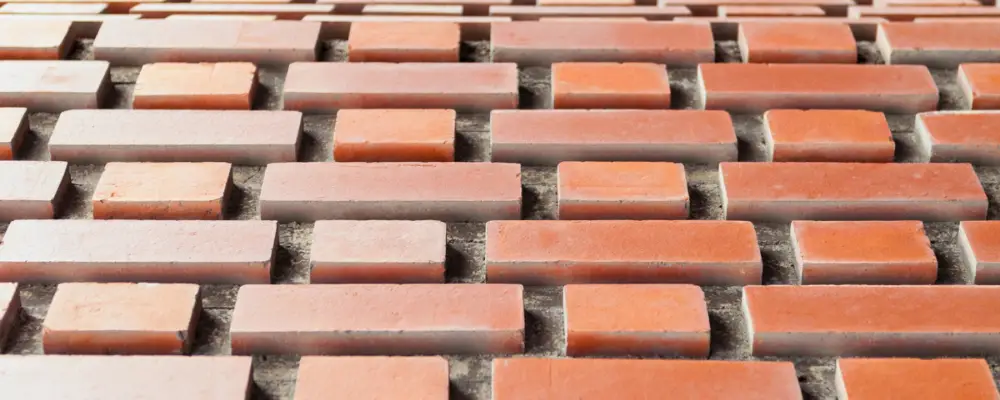Bond is a masonry/construction term that indicates the uniform arrangement of bricks/blocks to build a wall or a structure. These bonds ensure the strength, stability, appearance, and aesthetic properties of the structure. There are different types of bonds in masonry, each with its unique characteristics, properties, and applications. Among the different bonds, one fundamental bond is the header bond. In this blog, we take a look at what header bond is, its properties, pros, cons, and applications.
What is a Header Bond?
In brick masonry, the header is the shorter square face of the brick (4.5”x3”). In header bonds, bricks are laid as headers on the faces of the walls. As bricks are laid with the shorter side forming the face, this gives the full brick thickness to the wall (9”). In general, the overlapping bricks are kept equal to half the brick’s width. Three-quarter brickbats are used in alternative courses (quoins) to achieve the right alignment of the bricks.
Applications of a Header Bond
- Header bonds are used to construct thicker walls with a minimum thickness of around 9 inches.
- Cavity walls and partition walls can be built using the header bond.
- Header bonds can be used to lay the footings in the foundation for better distribution of loads.
- These bonds can be used to improve the visual appearance for aesthetic purposes.
- Ideal for constructing curved and round architectural structures.
- Construction of non-load-bearing walls, garden walls, and partition walls can be done.
Properties of a Header Bond
Visible Short Heads
Small heads of the bricks are visible on both sides of the structure, as they are laid on the face of the structure. These shorter heads are visible on both sides of the wall and can be used as design elements in non-plastered structures.
Quoins
Two three-quarter brickbats (3/4 bricks) are used in alternative courses as quoins. These are used in the edges, to create a bond and prevent the wall from collapsing if the bricks bond are arranged one over the other.
Thickness
The thickness of the wall that is built using header bond, will have a full brick thickness (around 9 inches), which is double the width of the stretcher bond.
Overlapping
The bricks that are laid one over the other are kept more than or equal to half the width of the lower brick head. This is to avoid stacking the bricks over others, which will cause poor structural integrity.
Stability
The arrangement of bricks in a header bond adds more pressure to the length of the structure and makes it less stable.
How to Construct a Header Bond?
- Prepare the mortar, by blending cement, sand, or other adhesives with the appropriate amount of water.
- Blend all the raw materials into a mixture that is suitable for binding the bricks together.
- Obtain the bricks necessary for the construction of the structure, (by choosing the right bricks and calculating the number of bricks required).
- Put some cement mortar on the ground surface with the right consistency, before placing the first layer of bricks.
- The bricks are placed over the cement mortar, with a shorter square head (4.5”x3”) as the face.
- Arrange all the bricks in the same alignment until the first row of bricks is placed with small gaps for mortar to bind them.
- Use a spirit level or bob to check whether the angle is accurately 90 degrees.
- Put some mortar over the first layer of brick and place bricks over it, in half of the width of the underlying brick.
- A 3/4 brickbat should be used as a quoin closer, on alternate layers, to help the correct arrangement of bricks.
Header Bond vs Stretcher Bond
| Header Bond | Stretcher Bond |
| The bricks are laid with their shorter heads (header) parallel to the face of the wall. | The bricks are laid with their long faces (stretcher) parallel to the face of the wall. |
| The walls that are built using a header bond are generally double the thickness of the stretcher bond. | The walls that are built using a stretcher bond are less thick (half the thickness) compared to the header bond. |
| Header bonds are ideal for constructing curved surfaces of a structure. | Stretcher bonds are widely used for various structures, including half-brick thick partition walls, thin garden walls, cavity walls and more. |
| This bond lacks strength and stability, which makes it unsuitable for load-bearing walls. | This bond is stronger and more stable than header bonds, but still is not used for load bearing walls in general. |
Pros & Cons of a Header Bond
Pros
- Header bonds provide good thickness to the walls, compared to other bonds.
- These bonds are easy to construct and do not require skilled labour.
- Header bonds are not only used for constructing walls but also for decoration purposes and layering the garden.
- These bonds are ideal for circular or curvy design structures.
Cons
- These bonds have low strength and are less stable, so they cannot be used for load-bearing structures.
- As headers are aligned on the face parallel to the wall, the pressure on the structure is delivered along the length of the wall, which can collapse the structure easily.
- These bonds are not recommended for very long straight walls, as they have less stability and strength.
Conclusion
Header bond is a type of brick masonry that is used to erect walls and other non-load-bearing structures. Although they are thick enough, the arrangement of bricks lacks load-bearing capacity and durability. They cannot be used for load-carrying structures, however, they are used for building partition walls, cavity walls, curved finishes, and garden walls. Will you be considering header bonds for your dream house?

